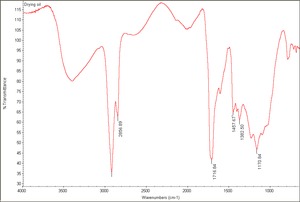Difference between revisions of "Drying oil"
| (3 intermediate revisions by 3 users not shown) | |||
| Line 9: | Line 9: | ||
Examples include: linseed oil; tung oil; perilla oil; sunflower oil; hempseed oil; safflower oil; lumbang oil; oiticica oil; stillingia oil; walnut oil | Examples include: linseed oil; tung oil; perilla oil; sunflower oil; hempseed oil; safflower oil; lumbang oil; oiticica oil; stillingia oil; walnut oil | ||
| − | == | + | [[[SliderGallery rightalign|Drying oil.TIF~FTIR (MFA)]]] |
| + | == Resources and Citations == | ||
| − | + | * L. Masschelein-Kleiner, ''Ancient Binding Media, Varnishes and Adhesives'', ICCROM, Rome 1995. | |
| − | + | * J.S. Mills, R.White, ''The Organic Chemistry of Museum Objects'', Butterworth-Heinemann, London, 1994. | |
* R. J. Gettens, G.L. Stout, ''Painting Materials, A Short Encyclopaedia'', Dover Publications, New York, 1966 | * R. J. Gettens, G.L. Stout, ''Painting Materials, A Short Encyclopaedia'', Dover Publications, New York, 1966 | ||
Latest revision as of 14:12, 21 August 2020
Description
Any Vegetable oil that will form a solid, nontacky film when spread into a thin layer and exposed to air for a few days. Drying oils solidify by polymerization and oxidation reactions that occur at the unsaturated carbon double bond (C=C) sites of some of their fatty acids. The greater the number of double bond sites available for reactions, the faster the oil will dry. All drying oils have at least 65% polyunsaturated fatty acids (oleic, linoleic, etc.). This high degree of unsaturation is indicated by a high iodine number (usually 120 - 200). Drying oils are obtained from the seeds, skins, and fruits of several plants, such as flax (linseed), poppy, walnut, safflower, and sunflower. Drying oils are mixed with pigments and used in artists paints or mixed with resins and used as varnishes and coatings. They have been used as a primary artist medium since the 15th century and may have been used as early as the 12th century. Driers, or siccatives, can be added to the oil-based paint to speed its drying time.
Synonyms and Related Terms
drying oils (pl.); aceite secante (Esp.); olio siccativo (It)
Examples include: linseed oil; tung oil; perilla oil; sunflower oil; hempseed oil; safflower oil; lumbang oil; oiticica oil; stillingia oil; walnut oil
Resources and Citations
- L. Masschelein-Kleiner, Ancient Binding Media, Varnishes and Adhesives, ICCROM, Rome 1995.
- J.S. Mills, R.White, The Organic Chemistry of Museum Objects, Butterworth-Heinemann, London, 1994.
- R. J. Gettens, G.L. Stout, Painting Materials, A Short Encyclopaedia, Dover Publications, New York, 1966
- G.S.Brady, Materials Handbook, McGraw-Hill Book Co., New York, 1971
- Ralph Mayer, A Dictionary of Art Terms and Techniques, Harper and Row Publishers, New York, 1969 (also 1945 printing)
- ASTM, "Standard Terminology Relating to Paint, Varnish, Lacquer and Related Products", Annual Book of ASTM Standards, Section 6, Paints, Related Coatings and Aromatics, ASTM, D16, 7-Jan, Jul-96
- Art and Architecture Thesaurus Online, http://www.getty.edu/research/tools/vocabulary/aat/, J. Paul Getty Trust, Los Angeles, 2000
